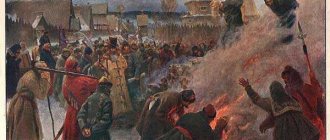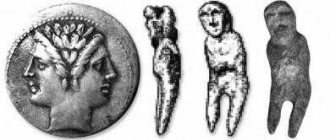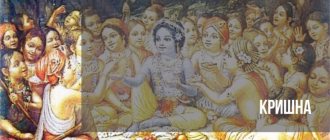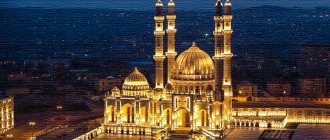What the article is about:
— What faith is professed in India in percentage terms? Features of the Hindu faith. What are the common features of the faith of Hindus and world religions. Vaishnavism and Shaivism are the main faiths of India. The process of creation of universes. Jesus Christ about the transmigration of souls (reincarnation) in the faith of Hindus in India. Vegetarianism in India. Basics, essence, description. Lecture on types of faith in India.
(Data from Wikipedia).
Hindu religion
According to 2001 data, the majority of Hindus in India profess Hinduism:
827,578,868 people . This constitutes more than 80 percent of India's total population. The vast majority of Hindus in India belong to the Vaishnavism and Shaivism faiths.
You can learn more about the religious direction “Vaishnavism” in the article: — RELIGION OF THE KRISHNAITS (VAISHNAVIS) —
Information about Jainism
Basically, this direction was followed by monastic sages - Jaimas, who lived very separately, preferred to be alone and accepted various kinds of ascetics.
They did not have any personal property, did not stay in the same place for a long time, did not eat meat, and generally ate a maximum of two times a day in small quantities.
Jains sometimes adopted very strict and severe austerities, for example, not uttering a word for several years, fasting for a long time, bringing themselves to the point of physical exhaustion, etc. There were two dharmic directions - those dressed in white and those dressed in light. The former covered their bodies with cloth, while the latter were always naked, because they believed that they were enveloped in sunlight. Not everyone could withstand the strict demands of this religion, so Jainism was never very popular.
What are the beliefs of Hindus, features, differences.
The Western world, after becoming acquainted with the culture and faith of India, became aware of such methods of self-knowledge as meditation, special breathing exercises, and yogic asanas. All this is part of the path of spiritual development, and is intended to calm the mind and control the senses. And yoga exercises are also for maintaining physical health. But all this is just the first step on the path of spiritual development. Meditation is intended for - perfect comprehension of your spiritual “I” (spiritual essence). Which ultimately allows the yogi to achieve exit from his physical body - without waiting for natural death, and subsequent transfer to other spheres of existence, or merging with the impersonal radiance of the Almighty (Brahman). Or - transfer to the material - “paradise” planetary systems of our universe, with a highly developed civilization, and incarnation there in a new physical body. (More details about the planets of “hell”, material “heavenly” planets are described in the site article: “DO HELL AND HEAVEN EXIST”
This is a difficult to implement branch of faith in India, which is called Jainism. The path of spiritual development itself is called “jnana yoga” (or it is also “jnana yoga”) . This is the philosophical path of understanding the all-pervading Brahman - the energy of the Supreme. Successful pursuit of this type of spiritual development involves complete renunciation of material sensory pleasures, a renounced lifestyle, and constant engagement in meditative knowledge of eternal spiritual existence. For a person who lives in modern society, such a path of advancement in spiritual self-knowledge is impossible. And yet, following the modern fashion for oriental innovations, many people practice meditation and yoga without even understanding the ultimate essence of this activity. The maximum effect from such activities (without complete renunciation of the world and everything “worldly”) will be only calming the mind and relative control of one’s emotions.
By the way, “jnains” are also mentioned in the sacred scripture about the journey of Jesus Christ in the “TIBETAN GOSPEL”. All this confirms the established fact that for many millennia, in most of the territory of modern Eurasia there was a Vedic civilization. By the way, the ancient Slavic Vedas reflect the same knowledge as the Vedas of ancient India. And this emphasizes one culture and faith that was on the mainland.
At the beginning of the twentieth century, a sacred scripture was discovered in one of the Tibetan monasteries, which, after its translation, was called “TIBETAN GOSPEL”. It told the story of the journey of young Issa at the age of 14 from Judea to India. The “TIBETAN GOSPEL” tells about the life of Saint Issa up to the age of 29 (precisely a period that was not covered in the canonical Christian scriptures). Here are some excerpts from this scripture: After a fifteen-year journey through India and Tibet, at the age of 29, Saint Issa returned to Judea, where he was executed by crucifixion.
..….10. And the disciples of Saint Issa left the land of Israel and went to all countries to the pagans, preaching that they need to leave gross errors and think about the salvation of their souls and the complete bliss that awaits people in an immaterial and full of splendor world, where in peace and in all His the great Creator dwells in purity in perfect majesty.
The full text of the holy scripture can be read by clicking on the link: “TIBETAN GOSPEL” (the page will open in a new “WINDOW”).
Jesus Christ did not agree with some aspects of the doctrine of transmigration of souls in the Hindu faith. He did NOT agree that the soul of a person after the death of the physical body can move into the body of an animal. The very knowledge about the transmigration of souls (reincarnation) does not apply specifically to the faith of India. The transmigration of souls into a new body (according to their past actions) was known everywhere, right up to the 3-4 centuries AD.
You can at least take a passage from the Bible: So here it is. By the decision of the Council of Constantinople, the knowledge of the transmigration of the soul was “cancelled” .
Vegetarianism in the faith of Hindus in India is not some peculiarity of the Hindu faith. As we mentioned a little earlier, the ancient Slavs also had a Vedic culture. And they also had their own direct commandments for this:
Some, supposedly “followers” of ancient Slavic culture, want to interpret the words: “
Do not eat food with blood” in such a way that meat must be bled before eating. This is what the Jews do in their tradition. But then it will not make sense what is said further in the commandment: “ You shall eat the clean food that grows in your fields, in your forests and in your gardens.”
That is, in plain text: “...food that GROWS in fields and forests.”
Refusal to eat animal corpses is a rule not only of the Vedic culture of the ancient Slavs and India. This is what Jesus Christ said about this:
469. And therefore he who kills kills his brother. 470. And the Earthly Mother will turn away from him and take away her life-giving breast. 471. And her angels will shun him, but Satan will find his abode in his body. 472. And the flesh of the killed animals in his body will become his own grave. 473. For truly I tell you, whoever kills kills himself, and whoever eats the flesh of slain animals eats the bodies of death. 474. For in his blood every drop of their blood turns into poison, in his breath their breath turns into stench, in his flesh their flesh turns into festering wounds, in his bones their bones turn into lime, in his entrails their entrails turn into rottenness. , in his eyes their eyes are like a veil, in his ears their ears are like a plug of sulfur. 475. And their death will become his death.
The entire text can be read by following the link: “THE GOSPEL OF THE WORLD OF THE ESSENES” (the page opens in a new “WINDOW”).
“THE GOSPEL OF THE WORLD OF THE ESSENES” was not included in the Christian canonical writings. Not everyone is ready to accept this kind of restriction in their diet.
The Bible itself, literally on its first pages, also clearly and unambiguously says: Research by modern scientists has proven the harm of eating meat and animal products. In addition to scientific research, statistics themselves speak for the true state of affairs. After the collapsed USSR stopped supplying meat and meat products to Cuba (there is practically no meat industry of its own in Cuba), the average life expectancy of Cubans has increased by 10 to 15 years in 20 years!
And here are the statistics of cancer diseases in India, Russia and Germany. It is also necessary to take into account that the level of medicine in India is lower than in Russia, and even more so in Germany:
Previous Vedism
The foundation of the religion of Ancient India was laid by the Aryan tribes in the second millennium BC. Scientists still cannot say for sure what place these natives came from and where exactly they went. But the fact that they influenced the formation of Indian civilization is an indisputable fact. The Aryans had a European appearance, they had blue eyes and blond hair. Their mixing with the dark-skinned population gave rise to new local tribes.
The Aryan religion consisted of many aspects. They believed that animals, plants, stones and trees have a divine essence. The key rituals in their religion were sacrifices, including human ones. The Aryans left behind the Vedas (texts consisting of sacred letters in four parts), which included the Rig Veda, Atharva Veda, Sama Veda and Yajur Veda. Later, Vedic wisdom was supplemented by brahmanas who tried to explain the laws of the universe.
In Vedism there was a large pantheon of gods . The Aryans were nomads, their living conditions were provided by cattle breeding, therefore Indra, the lord of rain and thunderstorms, was considered the king of the gods, standing at the center of the pantheon.
The pantheon also included other Vedic gods, for example, Dyaus - the god of heaven, Agni - the god of fire, Mithra - the god of order, Prithivi - the goddess of fertility. Moreover, the Aryans revered their ancestors and often deified dead people.
Germany:
In order to enlarge the graph, move the cursor over the picture and click on it with the left mouse button.
The graphs (above) show cancer mortality statistics If we take into account that the level of medical care in Russia, and especially in Germany, is much higher than in India, and quite a lot of cancer patients are cured, then the complete statistics of cancer cases will make an even greater difference.
Western countries and also in Russia became aware of Hinduism and the religious direction - “Vaishnavism” through the activities of the religious organization - “International Movement of Krishna (God) Consciousness”. You can learn more about this religious movement by reading the article on the site: - WHO ARE THE “HARISHNAITS” -
If you want to learn more about the peculiarities of the paths of spiritual development, I recommend reading or listening to a short lecture by the Indian saint, preacher, Vaishnava, author, translator and commentator of many sacred scriptures of India - Swami Srila Prabhupada, who is known to all theologians of the world for his dissemination of spiritual knowledge. The lecture gives a general principle of spiritual development that can be practiced in modern society.
Srila Prabhupada preached all over the world. Beatles group knew him and were personally acquainted with him
Srila Prabhupada is on the left, George Harisson is on the right.
Below is Srila Prabhupada's lecture.
Information about Brahmanism
Thanks to Brahmanism, castes emerged in ancient India. The basis for their definition was the myth of Purusha, who independently sacrificed himself in order to populate the globe. This story gave an understanding that every person has his place in society. Representatives of the castes are initially unequal, because all layers of society came from different parts of the Purush’s body.
According to the table, the following classification is distinguished:
- Brahmins originated from the mouth and ears of a divine being, so they have the honor of communicating with and hearing the Gods, as well as conveying their messages to people. Even a one-year-old baby from the Brahman caste was respected in society more than an elderly representative of any other caste.
- Kshatriyas (rulers and warriors), in turn, arose from God's hands, so they were endowed with the right to rule the people, become military leaders and judges.
- Vaishyas (farmers and artisans) emerged from the thighs and legs of the creator, so they were supposed to work hard to provide food not only for themselves, but also for representatives of the higher castes.
- Shudras (slaves and servants) arose from the feet of the deity, so it was believed that these people were forced to serve the higher castes.
- In turn, the untouchables came from the mud under the feet of the Purush, so whoever touched them became unclean. To prevent this from happening, newborn babies from this caste had a miniature star cut out on their foreheads and painted blue with an indelible liquid.
It was in Brahmanism that the concept of Samsara - the wheel of eternal life - appeared . If a person behaved sinfully, he will be punished according to the law of universal justice. At the same time, the doctrine of reincarnation and karma appeared, the meaning of which was that the soul is immortal and, as it develops, it incarnates into different bodies. This entire path takes place in an attempt to achieve spiritual perfection. However, not everyone accepted the strict caste division, so new, more democratic directions of this religion began to emerge.
Catholicism is the largest Christian denomination in India
Why is religion needed?
The Christian faith in India is represented by all denominations, with the largest of them being the Catholic Church.
Church tradition says that in the middle of the first century Christianity was preached by the Apostle Thomas in India. Around the same time, the first Christian communities appeared here.
At this time, the liturgy of the church in India was strongly influenced by the Assyrian Church of the East. Its center was located in the north of modern Iraq.
That is why the East Syrian rite has become widespread in the Indian church.
St. Thomas Cathedral, Chennai, India. Catholicism is the third largest religion in India. Photo: upload.wikimedia.org
Contacts between the Roman Catholic Church and Christians in India began in the 13th century, when the first Catholic missionaries began to arrive in India.
Arriving in Kollam in 1291 (in Latin it was called Quilon - Quilon), the Franciscan monk Giovanni Montecorvino discovered Christians of the Syrian tradition there. They called themselves Christians of St. Thomas the Apostle.
17300000
this is how many Indian citizens consider themselves Catholics
In modern times, Catholicism in India or the Catholic Church in India is part of the worldwide Catholic Church.
As of 2011, about 17 million 300 thousand people in India (2.4% of the total population) considered themselves Catholics.
There are three Catholic churches in the country: the Roman Catholic Church, the Syro-Malabar Catholic Church and the Syro-Malankara Catholic Church. The largest Roman Catholic Church.
The number of its parishioners is 14 million people. The Syro-Malabar Catholic Church has about 3 million people, the Syro-Malankara Catholic Church has about 300 thousand people. Each of them has its own ritual and its own structure.
His Eminence Cardinal Oswald Gracias is the President of the Catholic Bishops' Conference of India. Photo: upload.wikimedia.org
The Conference is the centralized and unifying body of the Catholic Church in India.
The centralized and unifying body of the Catholic Church in India is the Catholic Bishops' Conference of India.
In total, there are about 7 thousand parishes, 158 bishops, and about 11 thousand priests in the country. Twenty-one Catholic churches in India have been given the honorary title of Basilica Minor by the Pope (as of the end of 2012).
7000
this is the number of Catholic parishes operating in India as of 2012
Painting
Early Indian paintings are considered to be rock paintings from primitive times. Ancient, like temple painting, speaks of a love of naturalism. Religions such as Buddhism, Hinduism and Jainism became the basis of medieval painting. The representative of traditional classical painting of the Middle Ages was Raja Ravi Varma.
The most famous method of applying ornaments, especially in South India, is considered to be rangoli. Very often it is found on the thresholds of Indian houses.
There are many prominent genres in Indian art. These include Mongolian, Rajput, Mysore and others. Several such paintings can be seen at the Jahangir Art Gallery in Mumbai.
Zoroastrianism (<0.014)
One of the most ancient religious movements in human history today is extremely small in number, with no more than 200 thousand Zoroastrians left in the world. Followers of Zarathustra live in Iran and India.
The movement arose during the life of Zarathustra. But when exactly he lived, historians have not yet been able to find out. He had a vision of a supreme being, whom Zarathustra called Ahura Mazda. It is this moment that is considered the birth of a new religion, which preaches a dualistic understanding of the world, where good and evil exist.
The final formation of the religious movement occurred approximately 4 thousand years ago on the territory of Persia. This region was captured by the Arabs who preached Islam, and the Zoroastrians were forced to flee to India.
9
Principles of Shaivism
Shaivism can be called another branch of Hinduism.
The bearers of this religion strive to worship Shiva - the destroyer god, the lord of lightning and rain. He is capable of eliminating any city from the face of the earth in an instant and sending all kinds of diseases and troubles to the guilty people. In ancient times, Shiva was considered a symbol of destructive natural force, which in an instant could change mercy to anger.
Although Shiva is considered a cruel god, he loves and protects his family. His wife Parvati is the goddess of fertility and the patroness of the feminine. Its temples are constantly visited by representatives of the fair sex who dream of having children. The son of Shiva and Parvati - Ganesha - the god of wealth, financial well-being, valor and glory. One of the incarnations of Parvati is the many-armed deity Kali, the patroness of magic and sexuality.
Holi
This festival is dedicated to Holika, the evil demon goddess who opposes the supreme god of the Hindu pantheon, Vishnu. On the first full moon of the year, at the junction of February and March, Indians drive away Holika. During the day, Indians organize a cheerful procession with music and dancing. In the evening, a large straw effigy of the goddess is made, which is burned at the stake. People and animals jump over this fire. During the festival, you can see yogis dancing on hot coals. It is believed that in this way diseases and misfortunes are eliminated. The traditional drink of the holiday is thandai with bhang (Indian hemp), it is not recommended to get carried away with it. At the beginning of the festival, it is customary to sprinkle each other with colorful powders and pour colored water on each other. The paints are made from ground plants - turmeric, indigofera, henna, madder, sandalwood and others. At the end of the festival of colors, as Holi is also called, participants in the fun sprinkle each other with ashes and water mixed with earth.
Diwali
On October 27, India begins a five-day New Year celebration - Diwali. Another name is the harvest festival, or festival of lights. These days, Indians celebrate the victory of Krishna and Satyabhama over the demon of chaos Naraksura, as well as several other significant events - the return of Rama (one of the incarnations of Vishnu) from the forest hermitage, the appearance of Lakshmi from the ocean of milk, who is asked for material prosperity and good luck, the pacification of Krishna the proud Indra and the birth of the divine Buddha.
In addition, one day they celebrate the meeting of brother and sister Yama and Yami. In honor of this, Indians give gifts to their brothers and sisters, most often in the form of thread bracelets. They symbolize friendship, care, trust and protection of each other from outsiders. If a brother and sister were in a quarrel, then this is the most suitable day to make peace.
All of these events are celebrated by lighting symbolic lights, burning incense, fireworks, fireworks and bursting of firecrackers. For this reason, Diwali is called the festival of lights.
Traditional dances
India is famous for its folk dances, which have always had a warm and exciting attitude towards them. Archaeologists managed to find two ancient works that are already about 2000 years old. “Science of Dance” and “Reflection of Gesture” - this is how their names are translated into Russian.
Many people believe that the art of Indian dance is the self-expression of inner beauty and the presence of the divine in a person. Every facial expression is an emotion, every movement seeks to convey an idea. Indian traditional dance is a refined art that leaves no room for error.
There are a total of 8 classical forms of Indian dance, which has elements of mythology. All of them are recognized by the National Academy of Dance, Music and Drama of India. Some regions have stable forms of folk dance traditions that take their roots from the official ones. If you have the opportunity to see these dances with your own eyes, do not miss it.
More recently, international dance programs in major cities have begun to gain popularity. New forms of Indian dance, merging with the classics, will allow the viewer to see stories from the Bible.
Vegetarianism
It is generally accepted that Indians, at least for the most part, are vegetarians. This is true: approximately 80% of the inhabitants of this country eat only vegetarian dishes. The emergence of vegetarianism is usually attributed to the fifth and sixth centuries AD. It was then that Buddhists and Hindus adopted the concept of not harming living beings. Some religious groups do not even plow the land, so as not to harm the insects, but walk along the roads with brooms, which they use to brush away insects so as not to accidentally crush them.
20% of the Indian population are Muslims, Christians and representatives of other faiths. They eat meat food. Most often these are birds - chickens and, more rarely, ostriches, turkeys, geese, ducks and quails. Christians also allow themselves pork. As for beef, eating these animals is punishable by criminal court.
Culture of behavior
Indian sermons say that the main goal in life is to control your senses. Ancient scrolls and current strong cultural laws call on Hindus to be cordial in communication, to be good-natured and friendly with others and children, and at all costs to restrain manifestations of anger and irritation. Displays of flirtatiousness, public displays of affection (hugs and kisses), and antics are not welcome. In some cases, expressions of feelings may be punishable by law. All the restraint in the daily life of Indians has been formed over centuries, but the inhabitants have not lost naturalness in their lives.
Adherents of Hinduism prohibit drinking alcohol. You won't find hard drinks in restaurants, but some bars allow you to bring your own alcohol. On Fridays there is a single prohibition law; at this time it is practically impossible to get alcoholic drinks.
The role of the upper caste in society
As already noted, Brahmins are the highest Indian caste, whose representatives are universally respected. Brahmins do not have their own housing, they usually live in temples, but they can ask for shelter from any person, and no one can refuse to provide shelter and food to a brahman until he himself wishes to leave this house.
In addition to brahmins, there are magicians who are capable of performing rituals and solving problems of various kinds. Various holidays add special beauty to Hinduism. The events are attended by many people, the celebration is accompanied by the singing of traditional chants and dancing.
In Brahmanism there is a tradition of setting the bodies of dead people on fire and scattering the ashes over the Ganges River. After this, loved ones mourn for 10 days. There used to be an ancient custom of sati, which involved the wife of the deceased committing self-immolation on the funeral pyre of her deceased husband as a sign of exceptional devotion. However, it was not common in all communities and was banned long ago.
Worldviews of local residents
It is customary to walk around any buildings and especially temples on the left side. Another feature of the worldview of local residents is to consider feet unclean. It is not acceptable here to swing your feet while sitting and point your foot at the temple or another person. Most Indians prefer to sit cross-legged or have their legs tucked.
The attitude towards women in the country is special. The culture of India contributed to the organization of marriages, when parents chose the betrothed for the bride themselves. These Indian traditions have survived to this day. The birth of a girl in a family is considered literally a tragedy. Before marriage, a woman is prohibited from having any sexual contact, and this custom does not apply to men. A married Indian woman cannot leave the house without a specific purpose, and on walks she is accompanied by a man. In the country's large metropolitan areas, not all traditions are strictly observed, but the majority of Indian residents reverence them sacredly and follow cultural canons.
Concept of Hinduism
It is difficult to find a brief description of the Hindu religion, since it is not only a religion, but also an entire philosophy with its own moral norms and rules. This movement was based on knowledge that came from Vedism and Brahmanism; moreover, the concept of castes also laid the foundation for the Hindu religion.
The key deities of Hinduism are Brahma - the main god who created the world, Shiva - the one who protects it, and Vishnu - the entity that will destroy this world after its main mission is completed. Of course, every religion has its own feminine ideal. In this religion, this is the goddess Lakshmi, who protects family happiness, takes care of the hearth and patronizes arable land and agriculture.
One of the famous ideas of Hinduism is the worship of Krishna. Hindu culture is similar to Brahmanism, but it does not have such strict traditions in terms of asceticism, as well as division by caste. For this reason, this religion has gained so many admirers around the world.
National clothes
Indians have long tried on European clothes. Most young people from the urban population own jeans. And yet, national clothing does not leave the wardrobe of the inhabitants of the Hindustan Peninsula. This is not surprising. Cotton, silk, ramie and other fabrics from which everyday and festive clothes are made are something that India can rightfully be proud of. Weaving traditions go back to ancient times. This is a traditionally male profession, and the beautiful patterns woven onto saris and containing various symbols are the fruit of the imagination of hereditary artists and textile masters. They decorate fabrics for saris with embroidery, stencil designs, weaving, and sew in mirrors, stones, and metal jewelry. Saree fabrics are distinguished by great color diversity and brightness. The dark skin of Indian women looks great when framed by bright fabrics. Pale pastel colors don't suit them. Depending on the region of residence, saris are draped differently. Sarees are worn with small cholis.
In addition to saris, Indian women wear various trousers - loose bloomers and narrow, straight trousers. They have in their wardrobe long vests and jackets, as well as tunic dresses, which they borrowed from the men's wardrobe. In general, having visited India, many Europeans come to the conclusion that it is not always possible to determine the gender of an Indian dressed in national clothes - both women and men like to dress brightly, decorate themselves with metal bracelets and chains, and draw a bindi on their forehead.










